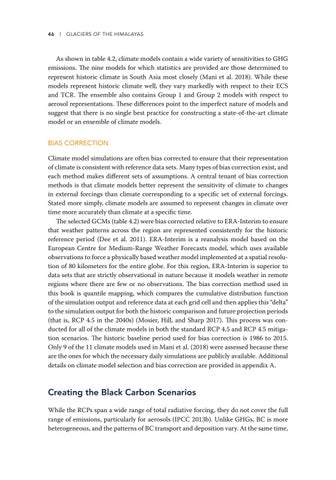46 l Glaciers of the Himalayas
As shown in table 4.2, climate models contain a wide variety of sensitivities to GHG emissions. The nine models for which statistics are provided are those determined to represent historic climate in South Asia most closely (Mani et al. 2018). While these models represent historic climate well, they vary markedly with respect to their ECS and TCR. The ensemble also contains Group 1 and Group 2 models with respect to aerosol representations. These differences point to the imperfect nature of models and suggest that there is no single best practice for constructing a state-of-the-art climate model or an ensemble of climate models. BIAS CORRECTION Climate model simulations are often bias corrected to ensure that their representation of climate is consistent with reference data sets. Many types of bias correction exist, and each method makes different sets of assumptions. A central tenant of bias correction methods is that climate models better represent the sensitivity of climate to changes in external forcings than climate corresponding to a specific set of external forcings. Stated more simply, climate models are assumed to represent changes in climate over time more accurately than climate at a specific time. The selected GCMs (table 4.2) were bias corrected relative to ERA-Interim to ensure that weather patterns across the region are represented consistently for the historic reference period (Dee et al. 2011). ERA-Interim is a reanalysis model based on the European Centre for Medium-Range Weather Forecasts model, which uses available observations to force a physically based weather model implemented at a spatial resolution of 80 kilometers for the entire globe. For this region, ERA-Interim is superior to data sets that are strictly observational in nature because it models weather in remote regions where there are few or no observations. The bias correction method used in this book is quantile mapping, which compares the cumulative distribution function of the simulation output and reference data at each grid cell and then applies this “delta” to the simulation output for both the historic comparison and future projection periods (that is, RCP 4.5 in the 2040s) (Mosier, Hill, and Sharp 2017). This process was conducted for all of the climate models in both the standard RCP 4.5 and RCP 4.5 mitigation scenarios. The historic baseline period used for bias correction is 1986 to 2015. Only 9 of the 11 climate models used in Mani et al. (2018) were assessed because these are the ones for which the necessary daily simulations are publicly available. Additional details on climate model selection and bias correction are provided in appendix A.
Creating the Black Carbon Scenarios While the RCPs span a wide range of total radiative forcing, they do not cover the full range of emissions, particularly for aerosols (IPCC 2013b). Unlike GHGs, BC is more heterogeneous, and the patterns of BC transport and deposition vary. At the same time,




